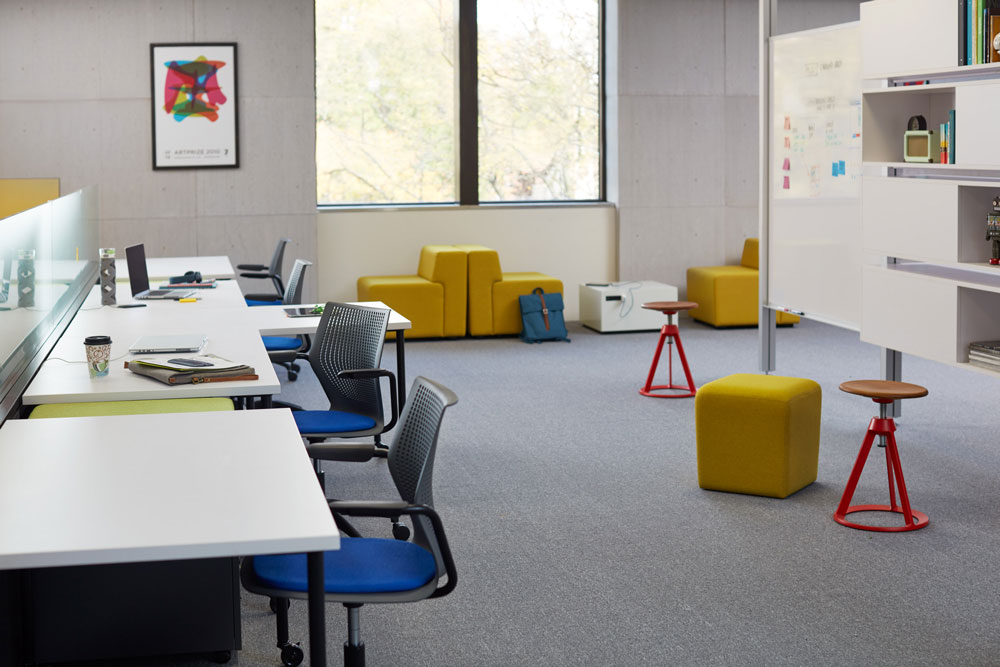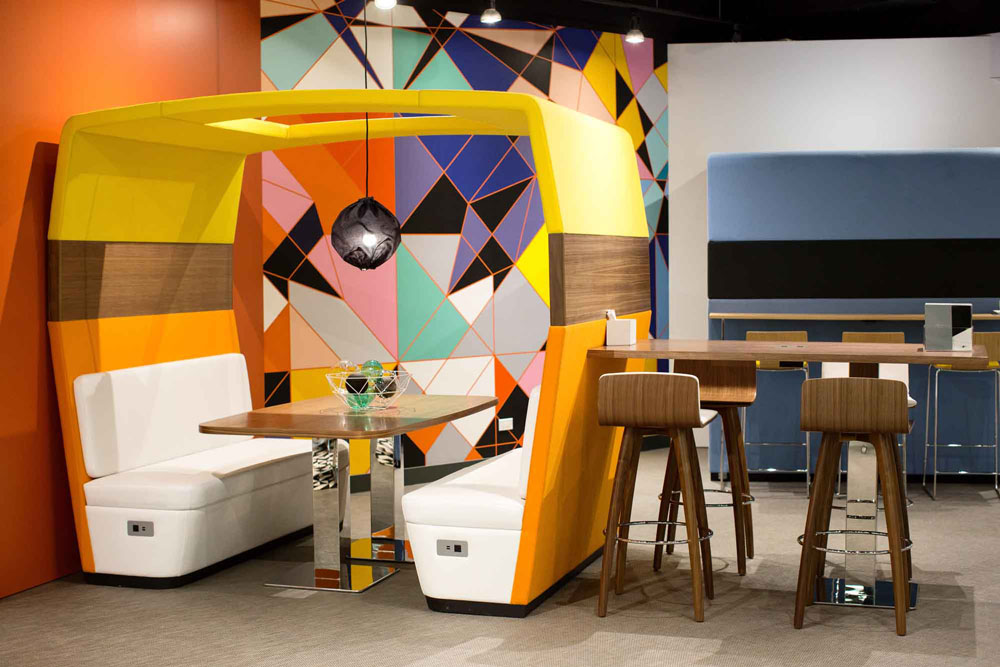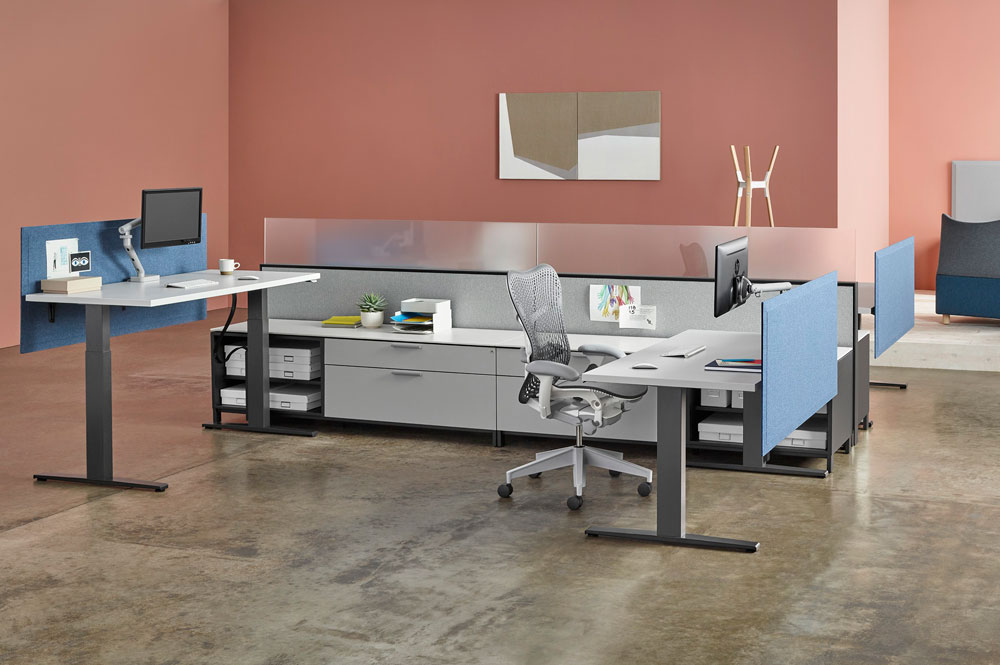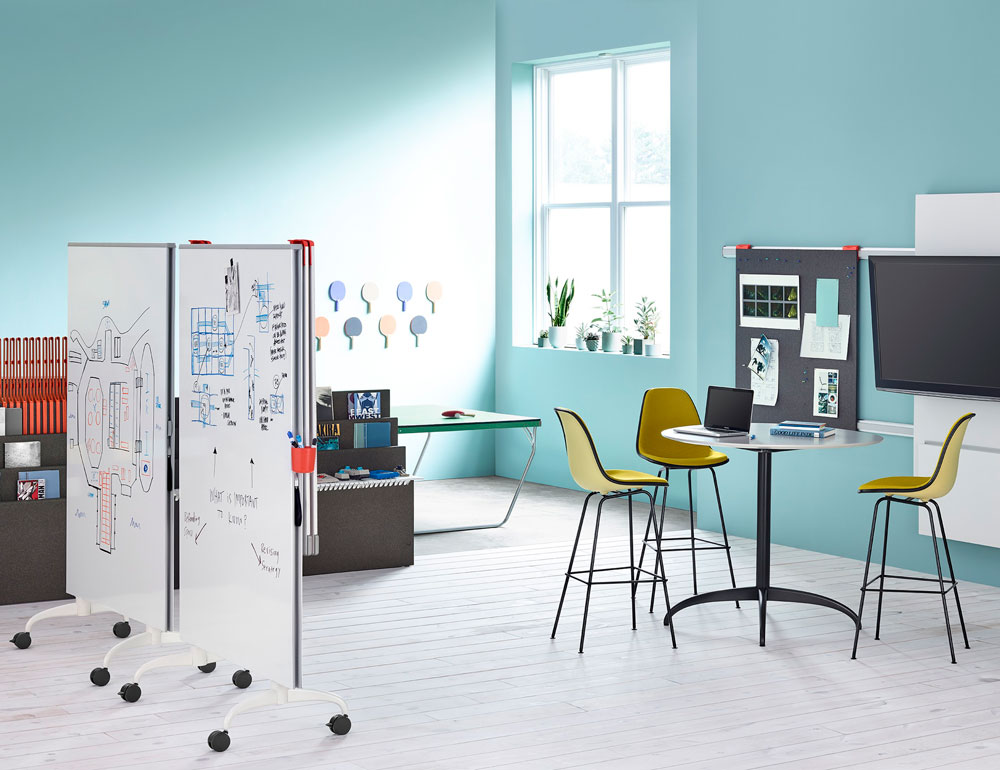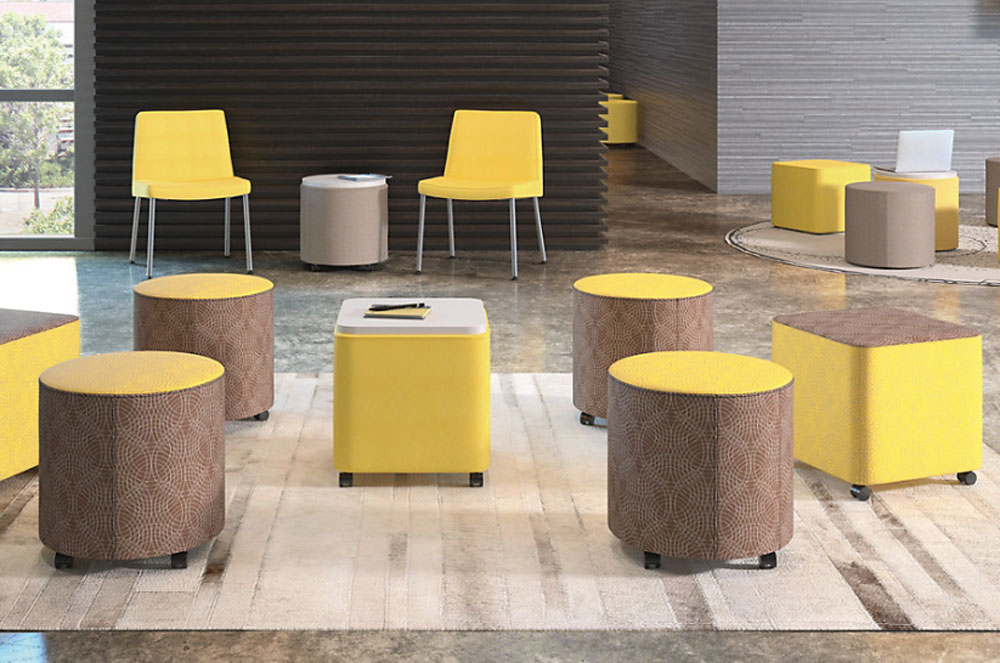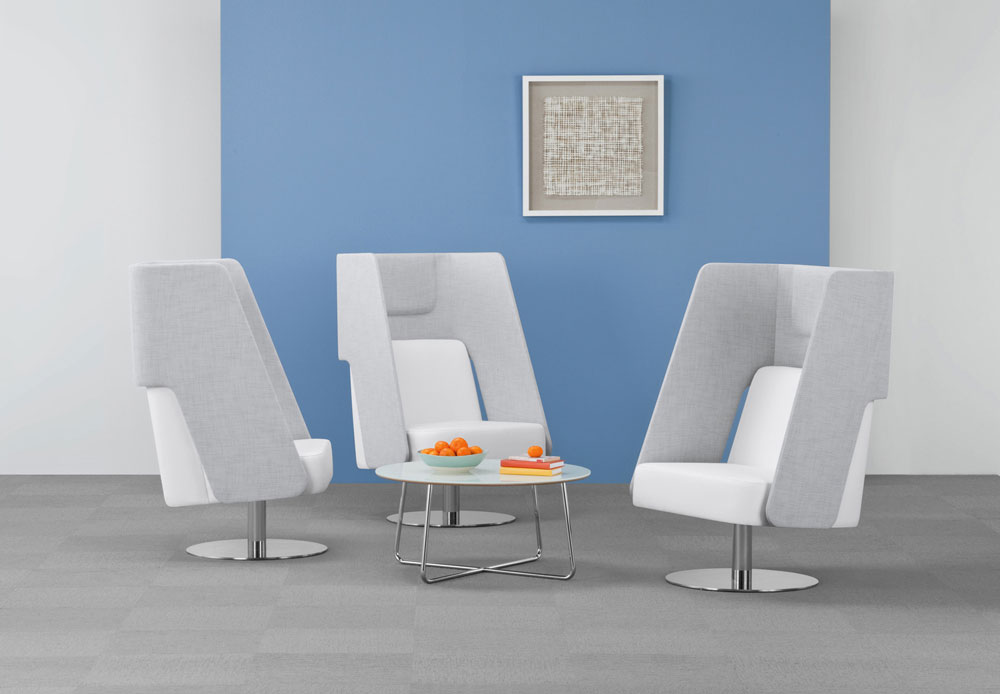SHRINKING FOOTPRINTS AND SHIFTING WORKFLOWS HAVE MADE POWERFUL OFFICE SOLUTIONS MORE ATTAINABLE THAN EVER. GETTING THERE REQUIRES COMMITMENT, ADAPTATION, AND A HEALTHY DOSE OF CREATIVE INSPIRATION
Knoll – Various Lines: Florence Knoll turned 100 this year, and the company that bears her name continues to innovate. Mainstays like the MultiGeneration Task Chair (foreground), whose perforated back is visually simple but designed for performance, are now complemented by a wider range of accessible products. That includes the k. collection (the k. lounge chair is featured along the rear wall, in yellow). “Our customers’ demands are coming at tighter price points,” said Melissa Regan, regional director for Knoll. “So being able to offer a products portfolio that is attainable while still meeting all of Knoll’s strict design guidelines is crucial.”
Words: Charlie Keaton
We live in an era marked by strategic disruption. No surprise then, that recent years have seen an especially dramatic shift in the way we design for (and function in) the office environment. Across virtually every industry, businesses have embraced the broader spectrum of elements that comprise a productive workplace. Today’s employers are wise to consider factors like health and wellness, or the changing dynamics of staff interaction, alongside more traditional design considerations.
As a result, the modern office is vastly evolved from what all but the most forward-thinking companies were doing a decade ago. This shift has done more than change the way our spaces look. For those wiling to invest in creativity and expertise, good office solutions are more attainable than ever.
One major reason for this is shrinkage–more specifically, the way individual workstations have gotten progressively smaller. With real estate costs surging, companies can no longer afford to allocate space in the sort of generic, one-size-fits-all manner that dominated generations past. Moreover, as the world has gone digital, many of the things we needed to do our jobs aren’t really things anymore.
The Arcadia Contract – Co-Op Meeting Space: For Herman Miller’s Locale collection, designers Kim Colin and Sam Hecht took inspiration from “thriving English high streets,” where the arrangement of local activities and services in close proximity fosters greater community collaboration.
“People just don’t need all that paper on their desks anymore,” says Frank Harney, principal of IE Connect. “Documents are all in the cloud. Monitors aren’t big and heavy like they were, and they can be raised off the desk anyway. Most people don’t have phones at their desks now. And filing cabinets have basically turned into a place to keep your snacks and workout gear.”
That shrinking footprint means many companies now spend less on individual workstations than ever before. A space that may once have required a $3,000 or $4,000 investment can now be outfitted for half that amount. But what looks on the surface like outright savings may be something, for many companies, more akin to reallocation. That’s because the move toward heightened interoffice collaboration has created demand for more breakout spaces and informal seating options.
Herman Miller – Motia: One of the most visible changes in the modern workplace has been the ascension (pun intended) of height-adjustable desks. It’s a good thing, as Americans now spend up to 21 hours per day sitting or sleeping. Herman Miller’s Motia Sit-to-Stand Table offers a durable, height adjustable office solution for nearly any budget. Privacy screens, monitor arms, and performance seating are easily integrated.
Herman Miller – Exclave: Exclave is a suite of products designed to keep the whole team engaged. Table shapes give participants clean sight lines to both digital and analog displays. Stackable boards and mobile carts allow for easy transport of ideas. Herman Miller bills Exclave as a “spatial ecosystem” that promotes collaboration, and it’s not hard to see why.
Employees may not require the isolated square footage of yesteryear, but collaboration–especially as it’s valued in today’s world–doesn’t happen in a vacuum. The creation of inviting, supportive spaces can open doors to new opportunities, and this reimagined footprint has fundamentally changed the flow and dynamics of office life. But these spaces also require investment, expertise, and a little bit of foresight.
Traci Lounsbury, principal and owner at ELEMENTS states, “You have to ask yourself and your team: ‘What kind of meeting space do we really want? How big is it? What kind of technology do we need? Is this a four-person meeting space, or six? If it’s six, do we want a head of the table or something round that promotes teamwork?’ There’s a lot more to the planning of collaborative spaces than people realize.”
In order to realize actual cost savings while still providing an effective, efficient workplace, flexibility is the name of the game. Just as job descriptions have flattened and blurred, office furniture has likewise become more fluid and adaptive. A conference table is useful, but one that can grow to accommodate larger groups, shrink for private meetings, or come apart for use as breakout space or to be stored elsewhere has value well beyond the sticker price.
Hon – Flock Collection: San Francisco-based designer Brian Kane has more than four decades’ experience creating furniture for hotels, airports and office environments. With the Flock collection, he turns his attention to common areas–especially, how to encourage greater teamwork by turning any space into an impromptu social opportunity. Chairs are available with round, tapered round, or tapered square legs, or a stool. As a whole, the seating, tables, and ancillary products that make up Flock provide a full collection of comfortable mobile elements for any workplace.
Flexibility also applies to adaptive reuse. “Things can sit empty because your culture doesn’t support it or it doesn’t work for your environment, and that’s really valuable real estate,” says Carla Dore, president and CEO of Workplace Resource. “So if you realize you’ve gone down a path that’s not great for your organization, the ability to be flexible and proactive and adjust accordingly is vital. It saves money, but also protects your assets and your people.”
Longevity matters, too. In light of the myriad expenses facing today’s businesses, weighing purchase price over long-term cost is a common mistake. “You obviously want a product you can afford on day one,” says Melissa Regan, regional director for Knoll. “But also something that will take you into the future. If you buy something that looks cool but is made cheaply, and you’re going to have to buy it again in five years, that hurts.”
Fortunately, technology has reduced the margin of error by giving clients unprecedented opportunities to visualize and experience their solutions. To be sure, technology has affected all aspects of the office solutions industry––from materiality to streamlined ordering processes–but nowhere more so than the ability to walk clients through virtual versions of their own offices. It’s no longer novel to see dealerships and manufacturers deploy multiple layers of cutting-edge visualization.
Encore – Visor Lounge: Visor is a collection with serious versatility. From casual breakout space to single-person. Visor offers public, private, and semi-private versions of lounge chairs and love seats for any office environment. Spruce up your solution with customizable options including cup holder, rotating tablet, and glides for hard-surface flooring.
Most offer renderings, and some programs–like DIRTT’s Java-based 3D application, ICE–provide multidirectional, photo quality renderings that allow clients to better grasp context and scale. But that’s far from the only tool available. Virtual Reality has arrived in a big way, allowing clients to don goggles for a lifelike walk-through while moving furniture or adjusting panel colors in real time. At the other end of the spectrum, a simple foam core mockup is surprisingly effective for understanding and optimizing not only configuration, but also issues like storage and privacy.
All of which adds up to rapidly evolving workspaces built on new priorities. Adds Dore, “It’s far less about the specific product, and much more about how to apply those products. Sometimes it might be health and wellness, or a particular technology, or collaboration. If you don’t understand the secret sauce around those things for a particular company, it’s too open ended.”
The days of 10 ft. x10 ft. workstations with 64-inch panels are gone, replaced by flexible products and spaces that adapt to changing demands. Smaller footprints and more affordable furniture, however, don’t automatically equate to flawless spaces on shoestring budgets.
“We can get you into a space for less money perhaps than we could have 10 or 20 years ago,” says Lounsbury, “but the decisions you’re making today are more critical. Within your space, you’re really feeding a culture with collaborative spaces and future flexibility and adaptability. It gets reasonably complex.”
That complexity underscores the issue at the heart of every modern office solution: Attainability is at an all-time high, but the best solutions are still built on a foundation of efficient and thoughtful design.


